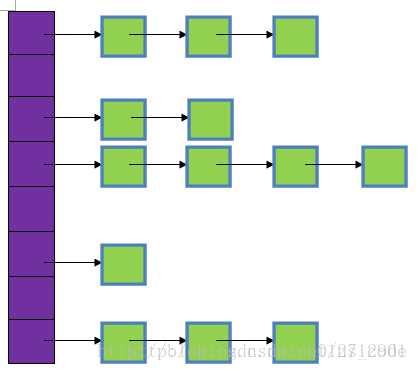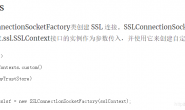背景:我们常用 HashMap 作为我们Java开发时的 K-V 数据存储结构(如 id-person,这个 ID 对应这个人)。我们知道他们的数据结构么,它的 Hash 值是什么意义。Hash 冲突是怎么解决的。我们带着这 2 个问题将 HashMap 做个整体剖析。(其实还有一个问题是,它怎么进行动态扩容的)
一、HashMap 的数据结构是什么。
下面是 HashMap 中的源码。其实 HashMap 的本质是 Node 数组;K-V 结构对应的基础数据结构就是以下源码
transient HashMap.Node<K, V>[] table;
static class Node<K,V> implements Map.Entry<K,V> {
//Hash 值
final int hash;
//Key 值
final K key;
//Value 值
V value;
//当前 Node 对应的下个 Node(用于解决 Hash 冲突;稍后讲解)
Node<K,V> next;
Node(int hash, K key, V value, Node<K,V> next) {
this.hash = hash;
this.key = key;
this.value = value;
this.next = next;
}
public final int hashCode() {
return Objects.hashCode(key) ^ Objects.hashCode(value);
}
}
根据上面代码我们知悉,HashMap 中基本的数据结构是 Node。
Map persons = new HashMap<String,String>();
//put 方法会新建一个 Node
//hash=k.hashCode() ^ k >>> 16 ; hash 是数组所在位置
//K="1",V="jack";next=null;(无 Hash 冲突情况)
persons.put("1","jack");
persons.put("2","john");
上述的 Node 数据结构中的 hash 值的意义是将 Node 均匀的放置在数组[]中。获得 hash 值后使用在 table[(n – 1) & hash] 位置置值。
/**
* Computes key.hashCode() and spreads (XORs) higher bits of hash
* to lower. Because the table uses power-of-two masking, sets of
* hashes that vary only in bits above the current mask will
* always collide. (Among known examples are sets of Float keys
* holding consecutive whole numbers in small tables.) So we
* apply a transform that spreads the impact of higher bits
* downward. There is a tradeoff between speed, utility, and
* quality of bit-spreading. Because many common sets of hashes
* are already reasonably distributed (so don't benefit from
* spreading), and because we use trees to handle large sets of
* collisions in bins, we just XOR some shifted bits in the
* cheapest possible way to reduce systematic lossage, as well as
* to incorporate impact of the highest bits that would otherwise
* never be used in index calculations because of table bounds.
*/
static final int hash(Object var0) {
int var1;
return var0 == null?0:(var1 = var0.hashCode()) ^ var1 >>> 16;
}
二、HashMap 怎么处理 hash 冲突
上述说道,Node 中的 hash 值是用 hash 算法得到的,目的是均匀放置,那如果 put 的过于频繁,会造成不同的 key-value 计算出了同一个 hash,这个时候 hash 冲突了,那么这 2 个 Node 都放置到了数组的同一个位置。HashMap 是怎么处理这个问题的呢?
解决方案:HashMap 的数据结构是:数组 Node[]与链表 Node 中有 next Node.
(1)如果上述的 persons.put(“1”,”jack”);persons.put(“2”,”john”); 同时计算到的 hash 值都为 123,那么 jack 先放在第一列的第一个位置 Node-jack,persons.put(“2”,”john”);执行时会将 Node-jack 的 next(Node) = Node(john),Jack 的下个节点将指向 Node(john)。
(2)那么取的时候呢,persons.get(“2”),这个时候取得的 hash 值是 123,即 table[123],这时 table[123]其实是 Node-jack,Key 值不相等,取 Node-jack 的 next 下个 Node,即 Node-John,这时 Key 值相等了,然后返回对应的 person.
三、HashMap 怎么进行动态扩容
JDK1.7 的逻辑相对简单,JDK1.8 使用了红黑树 TreeMap 相对复杂,现在用 1.7 的进行讲解。本质上其实一样。
void resize(int newCapacity) { //传入新的容量
Entry[] oldTable = table; //引用扩容前的 Entry 数组
int oldCapacity = oldTable.length;
if (oldCapacity == MAXIMUM_CAPACITY) { //扩容前的数组大小如果已经达到最大(2^30)了
threshold = Integer.MAX_VALUE; //修改阈值为 int 的最大值(2^31-1),这样以后就不会扩容了
return;
}
Entry[] newTable = new Entry[newCapacity]; //初始化一个新的 Entry 数组
transfer(newTable); //!!将数据转移到新的 Entry 数组里
table = newTable; //HashMap 的 table 属性引用新的 Entry 数组
threshold = (int) (newCapacity * loadFactor);//修改阈值
}
void transfer(Entry[] newTable) {
Entry[] src = table; //src 引用了旧的 Entry 数组
int newCapacity = newTable.length;
for (int j = 0; j < src.length; j++) { //遍历旧的 Entry 数组
Entry<K, V> e = src[j]; //取得旧 Entry 数组的每个元素
if (e != null) {
src[j] = null;//释放旧 Entry 数组的对象引用(for 循环后,旧的 Entry 数组不再引用任何对象)
do {
Entry<K, V> next = e.next;
int i = indexFor(e.hash, newCapacity); //!!重新计算每个元素在数组中的位置
e.next = newTable[i]; //标记[1]
newTable[i] = e; //将元素放在数组上
e = next; //访问下一个 Entry 链上的元素
} while (e != null);
}
}
}
static int indexFor(int h, int length) {
return h & (length - 1);
}
扩容的方式是新建一个 newTab,是 oldTab 的 2 倍。遍历 oldTab,将 oldTab 赋值进对应位置的 newTab。与 ArrayList 中的扩容逻辑基本一致,只不过 ArrayList 是当前容量+(当前容量>>1)。
JDK1.8 实现 resize()方式
/**
* Initializes or doubles table size. If null, allocates in
* accord with initial capacity target held in field threshold.
* Otherwise, because we are using power-of-two expansion, the
* elements from each bin must either stay at same index, or move
* with a power of two offset in the new table.
*
* @return the table
*/
final Node<K,V>[] resize() {
Node<K,V>[] oldTab = table;
int oldCap = (oldTab == null) ? 0 : oldTab.length;
int oldThr = threshold;
int newCap, newThr = 0;
if (oldCap > 0) {
if (oldCap >= MAXIMUM_CAPACITY) {
threshold = Integer.MAX_VALUE;
return oldTab;
}
else if ((newCap = oldCap << 1) < MAXIMUM_CAPACITY &&
oldCap >= DEFAULT_INITIAL_CAPACITY)
newThr = oldThr << 1; // double threshold
}
else if (oldThr > 0) // initial capacity was placed in threshold
newCap = oldThr;
else { // zero initial threshold signifies using defaults
newCap = DEFAULT_INITIAL_CAPACITY;
newThr = (int)(DEFAULT_LOAD_FACTOR * DEFAULT_INITIAL_CAPACITY);
}
if (newThr == 0) {
float ft = (float)newCap * loadFactor;
newThr = (newCap < MAXIMUM_CAPACITY && ft < (float)MAXIMUM_CAPACITY ?
(int)ft : Integer.MAX_VALUE);
}
threshold = newThr;
@SuppressWarnings({"rawtypes","unchecked"})
Node<K,V>[] newTab = (Node<K,V>[])new Node[newCap];
table = newTab;
if (oldTab != null) {
for (int j = 0; j < oldCap; ++j) {
Node<K,V> e;
if ((e = oldTab[j]) != null) {
oldTab[j] = null;
if (e.next == null)
newTab[e.hash & (newCap - 1)] = e;
else if (e instanceof TreeNode)
((TreeNode<K,V>)e).split(this, newTab, j, oldCap);
else { // preserve order
Node<K,V> loHead = null, loTail = null;
Node<K,V> hiHead = null, hiTail = null;
Node<K,V> next;
do {
next = e.next;
if ((e.hash & oldCap) == 0) {
if (loTail == null)
loHead = e;
else
loTail.next = e;
loTail = e;
}
else {
if (hiTail == null)
hiHead = e;
else
hiTail.next = e;
hiTail = e;
}
} while ((e = next) != null);
if (loTail != null) {
loTail.next = null;
newTab[j] = loHead;
}
if (hiTail != null) {
hiTail.next = null;
newTab[j + oldCap] = hiHead;
}
}
}
}
}
return newTab;
}





